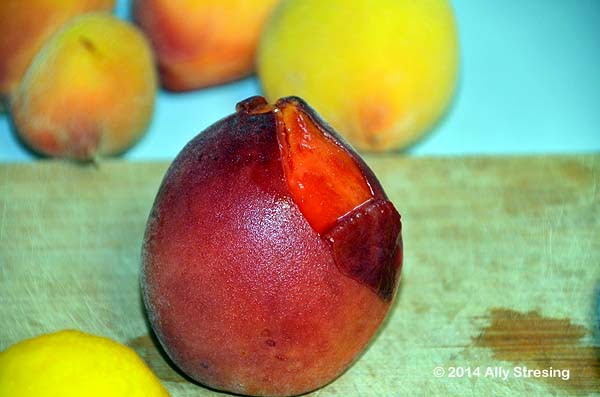Even better than a single peach ripening is a tree full of juicy, homegrown peaches all ripening in the warm spring sunshine.
In February 2013, we planted a home orchard with 6 fruit trees; two peaches, Junegold and La Feliciana; two apples, Ein Shemer and Anna; and two plums, Santa Rosa and Methley. We started with good sized trees in 5 gallon containers, but I think the bunny manure that we used to mulch the area is responsible for the fast rate of growth and our ultimate success.
In late winter 2014, we had an unexpected late freeze, which ruined our chances for a crop of apples and plums. The peaches lost a few blossoms, but by May 2014 the trees were covered in fruit. The heavy foliage kept most of the fruit well hidden. The trees stayed safe from predators until very late in the harvest when most of the peaches were off the trees.
Branches weighted down with peaches nearly touching the ground made me nervous that we would attract the attention of area wildlife. I checked the trees several times a day picking up any fruit drop that might start to rot and smell. I held my breath for almost 2 weeks fretting and waiting for a nighttime raccoon raid which never came.
We felt incredibly blessed with our first successful peach crop. We harvested 204 peaches in all not including spoilage fruits which went to the compost or the chickens.
I sold some of the best peaches at the farmer's market, but that still left a lot of beautiful peaches for home preservation.
When peaches are ripe, there's no time to waste. I kept the peaches in single layers on trays lined and covered with cotton flour sack clothes. I checked them daily and when the aroma and ripeness was at it's peak, I began to process them for the freezer.
The easiest way to slip off the skins is to slide the peaches into a pot of boiling for about a minute. I cut a small 'X' into the bottom of each fruit to assist with peeling.
Look at how nice and easy the skin peels off. Beautiful!
I boiled and soaked peaches in ice water, plus drained and peeled them seemingly simultaneously. Processing peaches is back crunching work and I can see why people like to put up harvests communally. An assembly line style processing methodology would be way more efficient than my haphazard method. I processed as much as my back could stand and saved the rest for the next day and the day after until they were all processed.
I cut up enough peaches to fill two sauce pans each time I processed.
I eventually developed my own rhythm for separating the peach slices from the pit. One thing I grew to appreciate was the important significance of cling vs freestone peaches. June Gold is a cling peach which was more difficult to process than the La Feliciana which is a semi-cling.
I froze some of the peaches in their own juice using citric acid as a preservative, but most of the peaches I converted to cobbler filling using my favorite recipe with plenty of brown sugar and cinnamon.
During peach season everyone ate well. The chickens got their share of peaches and there were plenty of cobblers, crisps and crumbles for the humans.
Even the compost pile ate well.
Peach season is the best! I can't wait to see what next year brings!
















